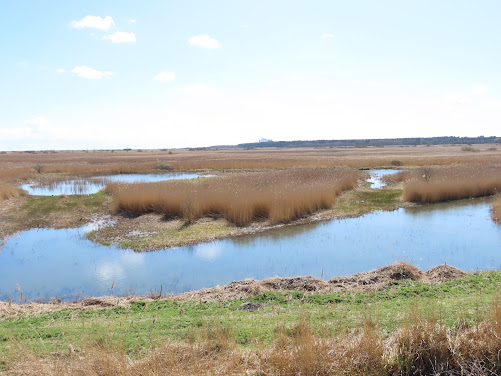With my photography needing some work on, I decided to enroll on a macro photography course at Bradfield Woods. Booked through the Suffolk Wildlife Trust, the course was run by Kevin and lasted for a couple of hours on a fine Saturday. Macro photography is the art of taking pictures of the small and close up, the focus on flowers and insects, and where better to take pictures of flowers, in late April, than Bradfield Woods nature reserve. Drifts of BLUEBELLS unfurl through the woods, the fading light of WOOD ANEMONES and OXLIPS, and newly emerging EARLY PURPLE ORCHIDS, it's a botanist's dream. A beautiful bounty of colours to amaze the senses, which made for some great photography.
The setup of the course was very informal, the teacher, Kevin, was a veteran of Suffolk Wildlife Trust photography sessions, someone I have worked with before at Lackford Lakes a few years ago. Kevin was very engaging, able to convey the art of photography very well and helped with my photography. Seven other people were on the course so it was fairly open, fairly intimate, and it meant the teacher's attention wasn't always somewhere else, he was always on hand when you had a problem. On the day we went to two different areas of the wood, areas which had very different flower communities, to give the best test to our photographic skills.
Bradfield Wood is one of the greatest ancient woods, in the UK. This ancient wood has been in existence for at least a thousand years old, and there may have been tree cover here since primordial times. Its very much a working site, the trees are coppiced, which is the act of cutting deciduous trees to a stump, from which further shoots sprout afterwards later on. Ancient woodland is great for flowers, and in late Spring, they appear in their finery, before the leaves grow on the trees, which effectively cut off the light they so need. Above the coppice, the odd tree had been left uncut, and therefore grew taller, but there were few truly ancient trees, as the site had been worked for so long.
Different parts of the forest had different flora, and often they appeared in large numbers. In the morning of this course we concentrated on an area of BLUEBELLS. Bluebells are great to photograph because they create such a spectacle, the wood hazel coppice stumps growing over a carpet of blue. Bluebells are tricky to photograph, as the camera's sensor often finds it difficult to catch the correct colour of the plants. Although they are called "blue" the plant is more a purple colour, and the camera finds this hard to fathom for some reason. To combat this imperfection, you need to tweak the white balance slightly to get the colour correct. Using a low F stop number and a middle shutter speed gave good depths of field, a requisite in macro photography, which gives nice close ups of the flowers in focus against a blurry background.
Because the bluebells were so numerous, there were so many variations, in the individual flower and in the larger scenery. Therefore each shot could be completely different just by changing position slightly, or adjusting the focus. Bluebell drifts are a wonder of nature, one that is confined in Europe predominately to the UK.
We delved further into the woods where a large stand of WILD GARLIC was growing, but unfortunately the plants weren't quite in flower, however the sea of leaves gave off the whiff of garlic on the still wooded air. There were a few white WOOD ANEMONE around but they were just coming out of flower, slightly tatty now, they tend to peak earlier in the month.
After lunch we went to a different part of the wood, a place where no bluebells were growing, but instead there was the bonus of EARLY PURPLE ORCHIDS growing there. The orchids are ancient wood specialists, and although they don't grow in large numbers, and were still emerging, they were still very much a great subject for photography. Little spikes of purple flowers would push up from the green undergrowth, beautiful colours only nature can produce. However they didn't provide quite the photographic opportunity the bluebells did. Yellow OXLIPS were growing in this part of the wood, but unfortunately the flowers were going over. A woodland version of the cowslip, they are very restricted in this county, found only in western Suffolk, eastern Cambridgeshire and Essex. This is a plant I've always wanted to see, and being so rare had never caught up with them until now.
The strange thing about plant photography is that with the subject standing still you only need to take one photo. Also the subject is not likely to be spooked and stands still so you can frame a shot as you want. So from today's session I only had several hundred photos. Compare that to bird photography, where the bird is moving constantly, you try to sneak up, constantly try to get closer, and can take a lot of photos of one subject, to hopefully get one good result, often not. As a result you take so many more photographs. But like birds plants wax and wane with the seasons, so what you may see at a site on one visit will change on another. Such are the wonders of nature and the bounty which she gives us.


















































